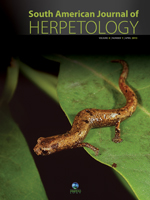The tadpole of Phyllomedusa bicolor is redescribed based on 147 individuals from 16 developmental stages collected in three areas of Central Amazonia. We compare them with other tadpoles of the genus found in the Amazon and provide comments on development sites. The tadpole of P. bicolor (stage 36) has a triangular body in lateral view and elongate body in dorsal view. The snout is rounded, the nostrils small and ovoid and the eyes are positioned laterally. Tail length is 61% of total length. The larva has a single, sinistral, almost ventral spiracle. The short vent tube is dextral and attached to the ventral fin. There is a unique cord on the dorsal fin, visible at all stages, originating at body terminus and extending almost to the tip of the tail. The anteroventral oral disc has marginal and submarginal papillae and a labial tooth row formula of 2(2)/3(1) at Gosner stages above 24. Tadpoles inhabit streamside ponds or ponds formed in streams of terra firme forests.
How to translate text using browser tools
1 April 2013
Redescription of the Tadpole of Phyllomedusa bicolor (Anura: Hylidae) from Central Amazonia
Rebeca Mc Comb Pinto,
Sarah Sampaio Py-Daniel,
Marcelo Menin
ACCESS THE FULL ARTICLE
<
Previous Article
|
Breeding site
larval morphology
ontogenetic variation





